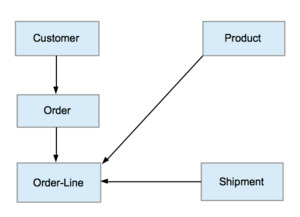Network model facts for kids
The network model is a way to organize information in a database. It was created to be very flexible. Imagine a map where different types of information are like cities, and the connections between them are like roads. In this model, these connections can go in many directions, not just in a straight line or a simple tree shape.
This model was made official by a group called CODASYL in 1969 and updated in 1971. That's why it's sometimes called the CODASYL model. Many network database systems were popular on large computers in the 1970s. However, they were mostly replaced by relational databases in the 1980s.
Contents
What is the Network Model?
Think of a hierarchical database model like a family tree. Each piece of information, called a record, has only one parent. But in the network model, a record can have many parents and many children. This creates a more complex, connected structure, like a spiderweb.
This structure applies to two main parts:
- The schema: This is the blueprint of the database. It shows how different types of records are connected.
- The database itself: This is where the actual information is stored. Each piece of information is connected to others.
The main advantage of the network model was that it could show relationships between different pieces of information more naturally. For example, one student might take many classes, and one class might have many students. This model could handle those connections well.
However, the network model didn't become the most popular for two main reasons:
- IBM, a big computer company, preferred its own hierarchical system.
- The relational model came along. It was easier to use and understand. It allowed people to ask for information in a simpler way.
In the past, network databases were faster for some large tasks. But as computers got faster, the relational model became more popular. It offered more flexibility and was easier to work with. This led to the network model being used less often in businesses.
History of the Network Model
The idea for the network model came from Charles Bachman. He helped create the first official rules for it in 1969 with the CODASYL group. These rules were updated in 1971 and became the basis for most network databases. Later, an international standard was created, but it didn't have much impact.
Bachman is also known for something called a Bachman diagram. This is a special drawing that shows how a network database is set up. In these diagrams, rectangles represent different types of records. Arrows show the connections between them, usually meaning one record can be linked to many others.
Examples of Network Database Systems
Here are some well-known database systems that used the network model:
- IMAGE for HP 3000 computers
- Integrated Data Store (IDS)
- IDMS (Integrated Database Management System)
- Raima Database Manager
- Univac DMS-1100
- Norsk Data SIBAS
- Oracle CODASYL DBMS for OpenVMS (originally called DEC VAX DBMS)
See also
 In Spanish: Base de datos de red para niños
In Spanish: Base de datos de red para niños
- Navigational database
- Graph database


